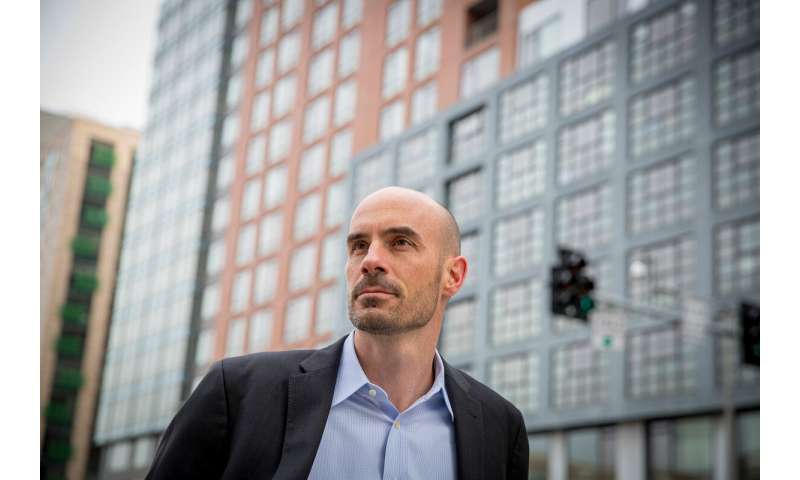
Joe Allen, assistant professor of exposure assessment science at the Harvard T.H. Chan School of Public Health and director of its Healthy Buildings program, suspects that broader airborne transmission of the coronavirus is likely, and thinks certain precautions indoors and out can help reduce its spread. Allen spoke with the Gazette about ways to stay safe during the pandemic.
Q&A: Joe Allen
GAZETTE: The Centers for Disease Control and Prevention has just recommended individuals wear cloth face coverings in public settings where social distancing is difficult. What do you think?
ALLEN: I had a piece in The Washington Post last week that makes the case that everyone should be wearing masks. It outlines four lines of public health benefits. First, a mask can catch large droplets. So if I cough or sneeze, these large particles get captured by the mask, which means I’m not affecting others. Second, if you and I were out, and even though we’re six feet apart but you are infectious and coughing, the homemade mask acts as a physical barrier for me. [Studies show that some droplets can carry up to 20 feet.] Homemade masks don’t work as well as professional masks, but the idea here is that something is better than nothing. [And since] there’s a critical shortage of professional masks they [should] be reserved for health-care workers. Thirdly, a mask also serves as a reminder not to touch your nose or your face and your mouth, which is a point of transfer for the virus. The last point is that it’s a really important and powerful social cue. It’s a reminder to all of us that this risk is everywhere, and we all need to do our part. And actually it should be considered a badge of honor. If I’m wearing a mask out in public it’s telling you that I’m concerned about your health. I’m worried I might be infectious asymptomatic or symptomatic. And I’m taking this seriously so I don’t infect others.
GAZETTE: Are there certain materials that are better than others that people can use to make their own masks?
ALLEN: I recommended using something that most people would have in their home right now: a 100 percent cotton T-shirt. The science says that can be fairly effective for capturing large droplets if I cough or sneeze, but also it can filter some of the smaller virus particles—not as good as a commercial mask, but good enough and certainly better than nothing.
GAZETTE: You are an expert in healthy buildings. How do you see life in offices changing when people eventually make the transition back to working on site?
ALLEN: Companies are going to come back to a different world where their workers have a heightened awareness about the risk of infectious disease transmission and how the building influences that. So people’s expectations are going to be very different. They’re going to be paying attention to things like the density of the space, the air quality in the space. I guarantee when everyone returns back to work that first day, we’re all going to look around and notice if we do or don’t have hand sanitizer. We’re going to notice if there are too many people in a crowded conference room. And that’s just the reality we face. The positive side here is that we can take steps to reduce risk, right? We know what to do. It’s all manageable. It’s not this helpless or hopeless situation. We just have to be smart about how we do it.
GAZETTE: What can managers and those in charge do?
ALLEN: I’m working with John Macomber from the Harvard Business School on a book that comes out this month where we address this exact question. We have been exploring how we can be more creative about de-densifying our buildings. So, you could go to alternate day strategies, extend the length of the day, have people work in shifts where you have some overlap but don’t have everybody there at the same time. That would also help reduce demand or pressures for everyone showing up on public transportation. If we’re going to really restart this economy, we’re going to need a lot of these clever strategies that at first blush may seem awkward or different but, I think, will become accepted pretty quickly. It reminds me of the first time I had an encounter with a neighbor. We kept six feet from each other and it felt awkward. But now I see my neighbors all the time when I go for a walk and it’s the norm and I don’t even think twice. And that shifted in a week. So I think what may initially seem really unusual to us as a work pattern or work practice will soon seem normal.
GAZETTE: What are your recommendations for how people at home can stay safe while they practice social distancing?
ALLEN: The basic principles of higher ventilation apply. Open your window, use a portable air purifier to filter out airborne particles, or use a portable humidifier because higher humidity can help fight the virus as well. If you have someone who’s sick in the home, there are other things you want to do. One, you want to try to isolate them in a particular room and limit the contact you have with them and the airflow between rooms. I also recommend that you have a set of clothes that you put on when you go into the room and then take them off when you leave. And of course, wash hands.
Source: Read Full Article
